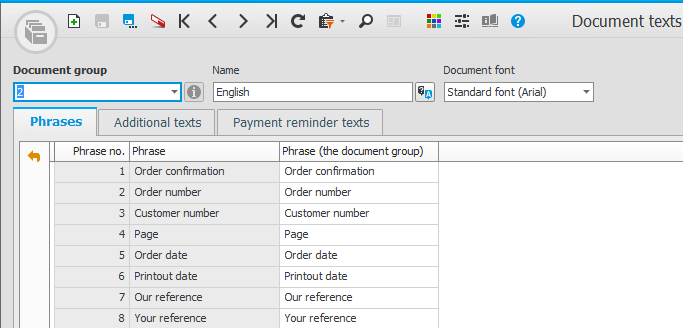Translating data and phrases
In many registers in Monitor ERP you can translate data to the different languages registered and set as active in the Languages procedure. What can be translated are texts for names, descriptions, explanations, etc. for different records. For these fields there is a translation table linked under the Translations button  . In the image below you see the button next to the Name field for payment terms in the Terms procedure.
. In the image below you see the button next to the Name field for payment terms in the Terms procedure.
In the translation table you can use the fields to enter a translation for each language of the text in question. For the company language the translation will be an alternative text. In the example the company language is Swedish. The translation for a certain language is shown for external documents (for example, purchase orders, order confirmations, invoices) and is determined by the language selected for the address of the document.
Above the translation table there is a field where you see the text in question in the company language. If the text in the company language should be changed, you can either make the change in this field or in the regular field to which the translation table is linked.
In the Document texts procedure it is also possible to translate phrases. These phrases exists in document group which you register in the procedure and then connect to a language in the Languages procedure. The phrases are the headings (lead texts) which occur on all printed documents. When you install the system, document groups with finished phrase translations are included for the languages you find under Language in backstage in Monitor ERP.
There are two purposes with translating data and phrases. These are:
- To get different languages on documents you send to foreign customers and suppliers, such as quotes, order confirmations, purchase orders, etc.
- That users in Monitor ERP should be able to see data in their own language. For example, if the company has an English CEO and a Finnish goods receiver, and they have selected English and Finnish for themselves in Monitor ERP.
You can translate data in different registers in the following procedures:
- Procedures starting with "Basic data
 With "basic data" we refer to the static records in a database, for example parts, customers, users, work centers, etc." in their name. For example the procedures Basic data – Parts, Basic data – CRM, etc. By using the function Find procedure (Alt + D) you will find all these procedures.
With "basic data" we refer to the static records in a database, for example parts, customers, users, work centers, etc." in their name. For example the procedures Basic data – Parts, Basic data – CRM, etc. By using the function Find procedure (Alt + D) you will find all these procedures. - Activities in different procedures.
- Manufacturing: BOM and routing, Work center
 A work center is a part of the factory. It can be a single machine or a group of machines, a single workstation or a group of workstations. register, Production schedules, Production schedule cycles, Configuration groups, Option lists, Variables.
A work center is a part of the factory. It can be a single machine or a group of machines, a single workstation or a group of workstations. register, Production schedules, Production schedule cycles, Configuration groups, Option lists, Variables. - Stock: Part register*, Register sales forecasts, Register case.
- Time recording: Schedules, Schedule cycles, Parameter groups.
- Accounting: Chart of accounts, Dimensions
 Dimensions are used by large companies in their accounting in order to divide up activities and make it easier to track internal results. An account is a dimension, although large companies usually use the dimensions cost center (CC), cost unit (CU) and project. In addition to these you can create other dimensions in Monitor ERP based on your own operational follow-up., Project register, Register fixed assets object, Create accounting report, Create VAT report.
Dimensions are used by large companies in their accounting in order to divide up activities and make it easier to track internal results. An account is a dimension, although large companies usually use the dimensions cost center (CC), cost unit (CU) and project. In addition to these you can create other dimensions in Monitor ERP based on your own operational follow-up., Project register, Register fixed assets object, Create accounting report, Create VAT report. - General registers: Calendars, Desktop templates, Voucher number series/Journals, VAT settings, Bank settings, Posting matrix, Budget charts, Invoicing plans, Document templates, Document texts, Departments, Authorization settings – EIM, User rights groups, Categories, Discount categories. And most of the procedures under Other tables, e.g. Terms, Number series, Price lists, Order types.
If no translation exists for the language selected for a customer's or a supplier's address, or a user's language in MONITOR, then the texts will instead be shown in the company language.
* The part register is normally extensive and it is not unusual that it contains several thousand parts. To make it easier, you can choose to only enter an English name and English extra name for the parts and not translated this data.






